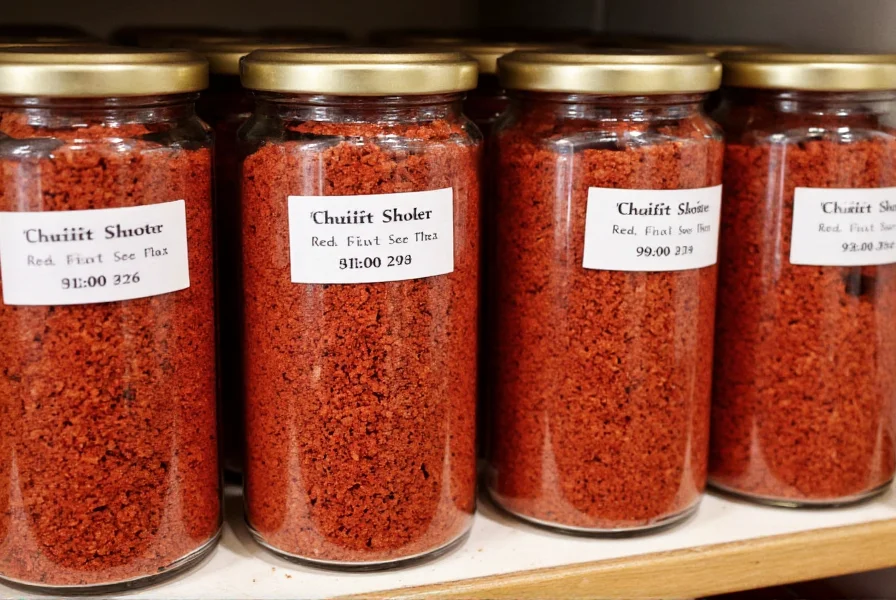What Exactly Is Crushed Red Chili?
Crushed red chili consists of dried chili peppers that have been coarsely ground into flakes. Unlike single-variety spices, commercial crushed red chili usually contains a blend of peppers including cayenne, ancho, and sometimes Aleppo or other regional varieties. This combination creates a complex flavor profile beyond simple heat.
The production process begins with fully ripened red chili peppers that are harvested, dried, and then mechanically crushed. The resulting product contains varying sizes of flakes, from fine particles to larger pieces, which contributes to its distinctive texture when used in cooking.

Crushed Red Chili vs. Red Pepper Flakes: Clearing the Confusion
Many consumers wonder about the difference between crushed red chili and red pepper flakes. In most commercial contexts, these terms are used interchangeably. However, subtle distinctions exist:
| Characteristic | Crushed Red Chili | Red Pepper Flakes |
|---|---|---|
| Composition | Typically multiple chili varieties | Often primarily cayenne |
| Flavor Profile | More complex, earthy notes | Sharper, more direct heat |
| Heat Level | Moderate (30,000-50,000 SHU) | Higher (50,000-70,000 SHU) |
| Texture | Varied particle sizes | More uniform flakes |
Understanding Heat Levels and Flavor Notes
The Scoville rating of crushed red chili typically ranges from 30,000 to 50,000 units, placing it in the moderate heat category. This makes it versatile for everyday cooking where you want noticeable warmth without overwhelming spice.
Unlike pure cayenne powder, crushed red chili offers additional flavor dimensions. The inclusion of multiple pepper varieties contributes earthy, slightly smoky notes that complement rather than dominate dishes. The seeds and membranes in the flakes provide the heat, while the red skin contributes color and additional flavor compounds.
Practical Culinary Applications
Professional chefs and home cooks use crushed red chili for specific purposes where its texture and flavor profile shine:
- Pizza and pasta dishes: Sprinkled on finished dishes for visual appeal and controlled heat
- Marinades and rubs: The coarse texture helps the spice adhere to meats
- Sauces and stews: Added early in cooking to infuse flavor throughout
- Infused oils: Steeped in olive oil to create versatile spicy oil
- Eggs and breakfast dishes: Provides gentle heat without overpowering delicate flavors
When using crushed red chili in cooking, remember that the heat intensifies over time. For immediate heat, add it near the end of cooking. For deeper, more integrated warmth, add it earlier in the cooking process.
Proper Storage Techniques for Maximum Freshness
To maintain the flavor and potency of crushed red chili, proper storage is essential. Exposure to light, heat, and moisture rapidly degrades both the color and heat compounds.
Store your crushed red chili in an airtight container away from direct sunlight and heat sources. A cool, dark pantry is ideal. For extended shelf life (up to 2 years), consider refrigeration in a moisture-proof container. Avoid storing near the stove or oven where temperature fluctuations occur.
Signs your crushed red chili has lost potency include faded color (from vibrant red to dull brown), diminished aroma, and reduced heat when tasted. Properly stored, crushed red chili maintains its quality for 1-2 years, though peak flavor occurs within the first 6-12 months.

Effective Substitutes When You're Out
When you need crushed red chili but don't have any available, several alternatives can work depending on your specific needs:
- Homemade blend: Mix equal parts paprika and cayenne pepper for similar color and adjustable heat
- Crushed Aleppo pepper: Offers comparable heat with more fruitiness (use 1.5x amount)
- Chipotle powder: Provides smokiness with moderate heat (use half the amount)
- Hot sauce: For liquid applications, use 1/8 teaspoon hot sauce per 1/4 teaspoon crushed chili
When substituting, remember that dried spices are more concentrated than fresh chilies. As a general rule, 1/4 teaspoon of crushed red chili equals approximately one small fresh chili pepper, finely chopped.
Frequently Asked Questions
Is crushed red chili the same as cayenne pepper?
No, crushed red chili typically contains a blend of several red chili varieties including cayenne, ancho, and others, while cayenne pepper is made exclusively from cayenne peppers. Crushed red chili has a more complex flavor profile and slightly lower heat level (30,000-50,000 Scoville units) compared to pure cayenne (30,000-90,000 Scoville units).
How much crushed red chili equals one fresh chili pepper?
Approximately 1/4 teaspoon of crushed red chili equals one small fresh chili pepper, finely chopped. This conversion works for most recipes, though heat levels can vary between brands. When substituting, start with less than you think you need, as you can always add more heat but cannot remove it once added.
Can I make my own crushed red chili at home?
Yes, making homemade crushed red chili is straightforward. Select fully ripened red chili peppers (a combination of cayenne, ancho, and other varieties works best), dry them thoroughly using a dehydrator or low-temperature oven, then crush them using a spice grinder or mortar and pestle. The homemade version will have fresher flavor and more vibrant color than store-bought options.
Why does my crushed red chili lose its color over time?
The vibrant red color in crushed red chili comes from carotenoid pigments that degrade when exposed to light, heat, and oxygen. Proper storage in an airtight container away from direct sunlight and heat sources helps maintain color. Faded color indicates reduced potency, though the product remains safe to consume if stored properly and shows no signs of moisture or mold.
What dishes work best with crushed red chili rather than other chili products?
Crushed red chili excels in dishes where you want visible spice elements and controlled heat distribution. It's particularly effective on finished dishes like pizza, pasta, and roasted vegetables where the flakes provide visual appeal. The coarse texture also works well in marinades and rubs where it adheres to food surfaces. For sauces and soups where uniform heat is preferred, chili powder or cayenne might be better choices.











 浙公网安备
33010002000092号
浙公网安备
33010002000092号 浙B2-20120091-4
浙B2-20120091-4